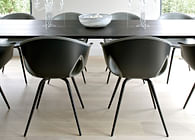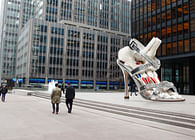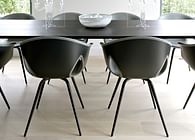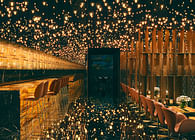
New York, NY
THE VILLAGE UNCOMMON
John Beckmann of Axis Mundi transformed a Greenwich Village townhouse into a treasure-filled home that's chic, unique and très today.
The bronze-and-glass room divider, which he designed with Richard Rosenbloom, is the result of months of thought about how best to apportion the parlor floor of his client's four-story 1846 Greek Revival townhouse in Greenwich Village.
The 2,550-square-foot house, which is 19 feet wide outside, had a typical Victorian floor plan, with a wall separating the foyer from the living room. Beckmann's client was hoping for a flowing, loft-like space, but the designer didn't want the front door to open right into the living area. So he began exploring ways to create the right amount of separation; over time he considered a panel of sandblasted glass and a wooden latticework screen. Then, during a trip to Urban Archaeology, the TriBeCa emporium of reclaimed architectural elements, he saw a cache of bubble-textured glass designed by Gio Ponti for Alitalia's Fifth Avenue ticket office in the 1950s. Beckmann decided to use the glass, along with panes of antiqued mercury mirror, to form a divider that is at once a shaper of space and a dazzling object in that space.
It was a signature move for Beckmann, who describes his work as "minimalist, but with added glamour" and who sees crisp white rooms as a starting point, not ends in themselves. "I like to insert a little bling-bling into every project," he says, "because that's the stuff people remember."
Before he began installing furniture and hanging art, Beckmann set out to create uncluttered surfaces. Where walls meet floors, there's a half-inch gap (known as a gallery reveal); where walls meet ceilings, there are narrow vents called slot diffusers. Beckmann, who worked for minimalist Joe D'Urso early in his career, was creating neutral backdrops against which he could arrange items with strong identities. His goal, he said, was to escape the confines of the narrow townhouse rooms. In the second-floor lounge, he mixed smallish pieces -- like the red Patrick Naggar sofa -- with larger ones (the gold-leaf bolt-of-lightning lamp by Dalí). The limestone fireplace surround, by Jasper Conran, gives the room architectural gravitas, while books, the owner's passion, give it human scale.
Beckmann faced a great challenge in the below-stairs kitchen, with its not-quite-eight-foot ceiling. Instead of making everything in the room diminutive, he installed a cooking island as large as a typical galley. "When you put a giant object in a small room," says Beckmann, "something exciting happens." The island is topped in brushed stainless steel and bleached oak that matches the elegant Boffi cabinetry. The floor of snow-white terrazzo tiles by Bisazza practically disappears, making the room feel taller than it is. Custom shutters with large round cutouts invoke the design work of Jean Prouvé and maintain privacy while allowing shafts of light to penetrate the space. Two metal "lolly columns" couldn't be moved; Beckmann covered them in anodized aluminum sleeves in cruciform shapes: a necessity turned into an architectural attention-getter.
Beckmann's client, who grew up in a Manhattan apartment, says he has always dreamed of living in a townhouse. As a teenager, he says, he ran away from home one night and camped out on the front stoop of a brownstone, fantasizing that the owners would come down and let him in. (In his family's flat, he says, if he made too much noise, the neighbors would complain).
So when his career as an investment banker took off, he began looking for a townhouse. The one he found, in the West Village, was in move-in condition (or so he thought). He ordered a new kitchen from Boffi and started shopping for furniture from such showrooms as New York's Ralph Pucci and Milan's Sawaya & Moroni.
But the cabinets couldn't be installed until the building's wiring and plumbing were updated. One thing led to another -- the five-word summary of every renovation job -- and soon he needed a designer. A salesman at Pucci recommended Beckmann. Then the contractor, who discovered structural problems the owner hadn't known about, was recommending that the interior be gutted. Two more years went by before Beckmann could install the furniture the client had already bought (plus other pieces they had purchased together). But the wait was worth it, according to the owner, who credits Beckmann with easing high-profile Armani and Versace furniture into a composition that goes beyond fashion. "Now, whenever I'm in someone else's house," he says, "I look around and I think, 'They should have talked to John.'"
- Fred Bernstein, Met Home
Design Team: John Beckmann and Richard Rosenbloom
Status: Built
Location: Greenwich Village, NY, US
Firm Role: Architecture and Interior Design



















